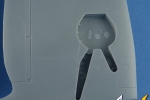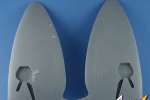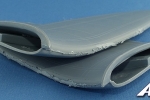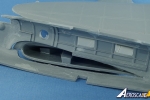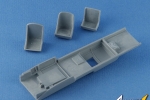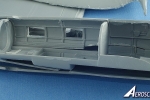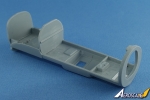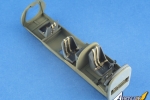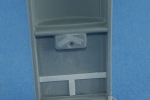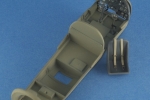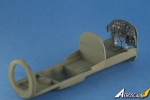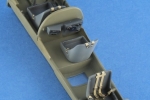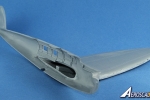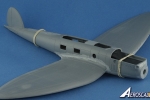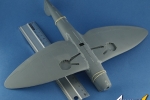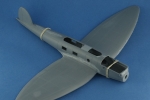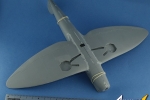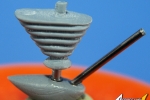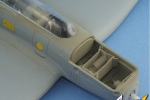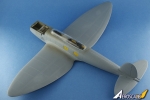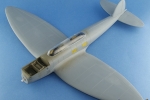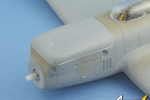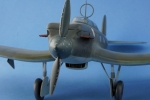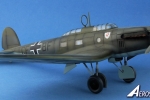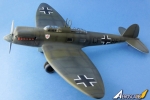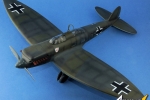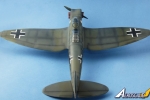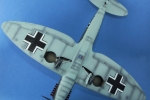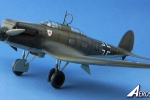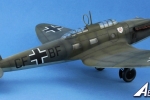1⁄48Heinkel He 70 Blitz
4
Comments
history
The He 70 Blitz (Lightning) was developed for Deutsche Luft Hansa as a high speed mailplane and light airliner. First flying in 1932, the Blitz was used to link Berlin with Frankfurt, Hamburg and Cologne. It also flew the Hamburg/Cologne route. Internationally, it formed part of Luft Hansa's South American mail route, flying the Stutgart/Seville portion of the run. By 1937, all of Luft Hansa's He 70s were transferred to the Luftwaffe. There they served as high speed bombers and reconnaissance aircraft, achieving good results in Spain as part of the Legion Condor. Once replaced by purpose-built aircraft, they were withdrawn from front-line service and used as high speed communications aircraft for senior officers.The aircraft's main weakness was caused by the extensive use of magnesium alloy in its construction. This and the large wing fuel tanks made the aircraft extremely vulnerable to fire. It was rumoured that a single rifle-calibre bullet hit could cause the aircraft to burst into flame.
The Blitz did not serve extensively in the Second World War, but it influence was far greater than its small production numbers might otherwise indicate. The He 111 was directly influenced by it, being a scaled up twin engined version of the basic He 70 design. The He 70 also lent its wing design to the He 112 fighter, and through diplomatic efforts with Japan heavily influenced the design of the Aichi D3A “Val” dive bomber.
Contrary to urban legend, Reginald Mitchell did not copy the He 70's elliptical wing for the Spitfire, but it is certain that he was impressed by its smooth lines and flush-riveted construction. The Spitfire therefore owes some of its classic look indirectly to Heinkel.
the model
AZ Model have recently released 2 versions of this kit in 1/48 scale. It's a typical limited-run model very reminiscent of a mid-run Classic Airframes kit, but without any resin or brass to complicate the build.Rafał found the model quite challenging. There are numerous sink marks to fill and the fit needs adjusting at almost every part. The interior is too large to fit inside the fuselage without a lot of grinding down. Rafał did some scratchbuilding and added photoetch in the cockpit which improves the look immensely. The tail skid was enhanced and strengthened by metal rod in place of the plastic parts. Rafał took the interesting step of gluing the wings before the fuselage halves had been joined. This allowed him to refine the fit from inside and outside.
As a crowning touch, Rafał installed a small electric motor in the nose to spin the propeller. This requires the upper engine cowling to be removable, and Rafał needed to do a fair bit of work in order to make it fit neatly without glue.
Comments
What a great build ! The chipping on the spinner/prop is particularly effective, and I am going to remember the trick of fitting the wing to the fuselage halves when there are fitting issues as well, very neat.
Congrats Rafal, very impressive work.
Cheers, D
APR 27, 2012 - 03:24 PM
Great work, Rafal. You did a good job on it and the end result looks great.
Thanks for sharing
APR 28, 2012 - 12:42 PM
Hi Rafal
Beautiful build! I have to admit I was really hoping ICM would release a 1:48 He 70 after reviewing their very neat little 1:72 version, but that doesn't look likely now AZ Model have one. I'll still consider buying this, but it's obviously one heck of a lot of work to build it anything like as well as you've shown us here!
All the best
Rowan
APR 28, 2012 - 10:20 PM
Copyright ©2021 by Rafał. Images also by copyright holder unless otherwise noted. The views and opinions expressed herein are solely the views and opinions of the authors and/or contributors to this Web site and do not necessarily represent the views and/or opinions of AeroScale, KitMaker Network, or Silver Star Enterrpises. Images also by copyright holder unless otherwise noted. Opinions expressed are those of the author(s) and not necessarily those of AeroScale. All rights reserved. Originally published on: 2012-04-28 00:00:00. Unique Reads: 12730





